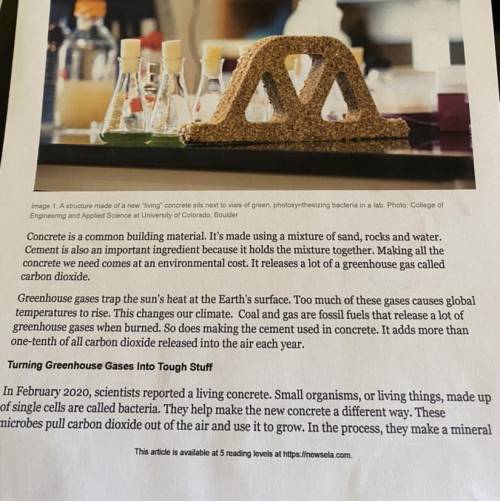
Complete of the article
that helps toughen the new concrete, notes wil Srubar. He is a scientist at the University of
Colorado Boulder. He's also part of the team that developed the concrete.
His team mixed the microbes together with sand. They also added a protein found in bones called
gelatin. Then, they added nutrients that help the bacteria grow. The scientists chose to add
cyanobacteria to their concrete. Cyanobacteria are like the bacteria or green algae that grow in a
fish tank. These bacteria can perform photosynthesis. It is a process that uses carbon dioxide and
light to make food.
The process does not release carbon dioxide, unlike cement. It even stores carbon in the living
cement
The bacteria also make a mineral called calcium carbonate. It is an important ingredient in
cement. Those bits make the new concrete tougher once it is cooled. Cooling the mixture also
makes the gelatin harden. It's just like cooling a jiggly gelatin dessert.
Imagine Living LEGOs, But With Flaws
What if the bacteria survived in the hardening concrete? Srubar's team thought the bacteria might
help make material for new bricks, too. To test the idea, they split a block and melted its pieces.
They added more nutrients to the mix. The bacteria grew. Then, they added sand. They had
enough bacteria and material to build two new concrete blocks. The team split and grew the
material until they made eight bricks from the original block.
But this new approach won't put an end to regular
concrete just yet. Srubar's group works in a lab where
contamination is easy to avoid. In the real world,
other microbes might get into the mix. Other
microbes could take over if they grow faster than the
cyanobacteria. Those other microbes might prove
harmful. Or they might change how the concrete
behaves
Cyanobacteria also need certain things to stay alive.
They won't survive well where it's dry. The living
concrete may only work in places that are warm and humid all year.
Scientists are excited even if it takes a while. There are lots of ways living materials might be used
in the world. "Nature has figured out a lot of really cool things that we can use in our day-to-day
lives," Srubar says. "We just have to pay a little more attention."


Answers: 1
Other questions on the subject: English

English, 21.06.2019 16:00, KKHeffner02
All of the following quotes are examples of foreshadowing from the swimming contest except
Answers: 1

English, 21.06.2019 16:30, sabrinakholikov
Write a summary about what you have learned about interpreting literature and presenting it to an audience.
Answers: 2


English, 22.06.2019 07:00, sgalvis455
Read this passage from "the city without us" by alan weisman: which statement best explains how the structure of the passage supports the author's purpose? a. the passage traces several events in the order that they will occur to highlight how nature conquers human civilization. b. the passage shows that natural forces such as an absence of predators and an increase in the squirrel population can lead to destructive results. c. the passage shows that natural forms such as an absence of predators and human hunters can lead to the reforestation of new york city. d. the passage identifies how two natural forces are co-dependent - the deforestation of new york and the extinction of squirrels.
Answers: 1
Do you know the correct answer?
Complete of the article
that helps toughen the new concrete, notes wil Srubar. He is a scientist at...
Questions in other subjects:

Mathematics, 05.05.2020 16:39

Health, 05.05.2020 16:39



Mathematics, 05.05.2020 16:39

Biology, 05.05.2020 16:39


History, 05.05.2020 16:39

History, 05.05.2020 16:39







